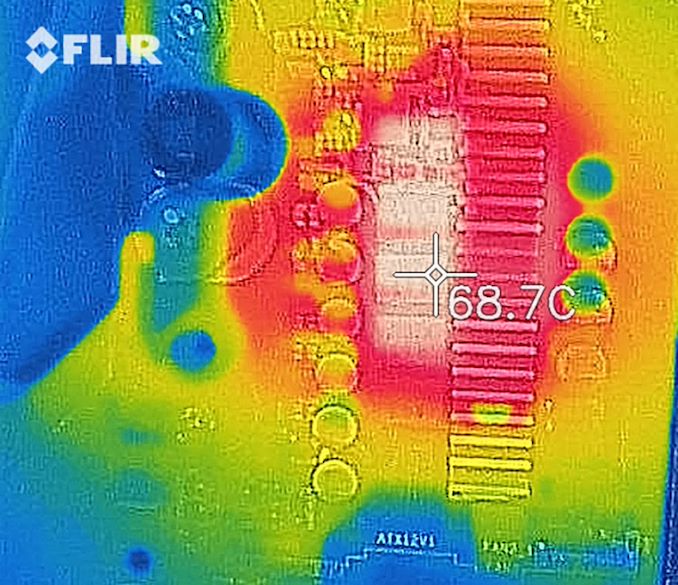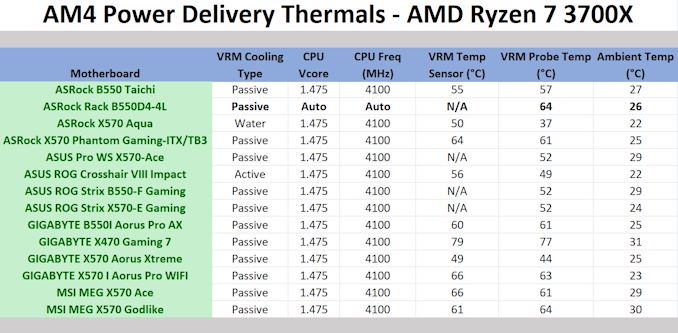ASRock Rack B550D4-4L Motherboard Review: B550 Goes Professional with BMC
by Gavin Bonshor on May 20, 2021 9:00 AM ESTPower Delivery Thermal Analysis
One of the most requested elements of our motherboard reviews revolves around the power delivery and its components. Aside from the quality of the components and its capability for overclocking to push out higher clock speeds which in turn improves performance, is the thermal capability of the cooling solutions implemented by manufacturers. While almost always fine for users running processors at default settings, the cooling capability of the VRMs isn't something that users should worry too much about, but for those looking to squeeze out extra performance from the CPU via overclocking, this puts extra pressure on the power delivery and in turn, generates extra heat. This is why more premium models often include heatsinks on its models with better cooling designs, heftier chunks of metal, and in some cases, even with water blocks.

The CPU section of the 6-phase (4+2) power delivery on the ASRock Rack B550D4-4L motherboard
Testing Methodology
Out method of testing out if the power delivery and its heatsink are effective at dissipating heat, is by running an intensely heavy CPU workload for a prolonged method of time. We apply an overclock which is deemed safe and at the maximum that the silicon on our AMD Ryzen 7 3700X processor allows. We then run the Prime95 with AVX2 enabled under a torture test for an hour at the maximum stable overclock we can which puts insane pressure on the processor. We collect our data via three different methods which include the following:
- Taking a thermal image from a birds-eye view after an hour with a Flir Pro thermal imaging camera
- Securing two probes on to the rear of the PCB, right underneath CPU VCore section of the power delivery for better parity in case the first probe reports a faulty reading
- Taking a reading of the VRM temperature from the sensor reading within the HWInfo monitoring application
The reason for using three different methods is that some sensors can read inaccurate temperatures, which can give very erratic results for users looking to gauge whether an overclock is too much pressure for the power delivery handle. With using a probe on the rear, it can also show the efficiency of the power stages and heatsinks as a wide margin between the probe and sensor temperature can show that the heatsink is dissipating heat and that the design is working, or that the internal sensor is massively wrong. To ensure our probe was accurate before testing, I binned 10 and selected the most accurate (within 1c of the actual temperature) for better parity in our testing.
For thermal image, we use a Flir One camera as it gives a good indication of where the heat is generated around the socket area, as some designs use different configurations and an evenly spread power delivery with good components will usually generate less heat. Manufacturers who use inefficient heatsinks and cheap out on power delivery components should run hotter than those who have invested. Of course, a $700 flagship motherboard is likely to outperform a cheaper $100 model under the same testing conditions, but it is still worth testing to see which vendors are doing things correctly.
Thermal Analysis Results

We measured 68.7ºC on the hottest part of the power delivery during our testing
The power delivery on the B550D4-4L is using premium components but isn't adequately cooled for performance users. It features a 4+2 phase power delivery, which is driven by an Intersil ISL69247 PWM controller, which is capable of handling up to eight channels. The CPU section is located on the opposite side of the board from the SoC area, and ASRock Rack includes four Renesas ISL99390 90 A power stages designed to deliver a maximum of 360 A to the processor. The SoC section is using two Renesas ISL99390 90 A power stages.
The ASRock B550D4-4L motherboard is using premium components for its 6-phase power delivery, with each phase consisting of a Renesas ISL99390 90 A power stage. It is controlled by an Intersil ISL69247 PWM controller operating in a 4+2 configuration. Boards such as these are typically built to specification, without the glorification of high-end components and over-engineered designs. As a result of the lack of optimal heatsinks designed to keep it cool, we only tested the board at stock settings. Despite offering some overclocking functions in the firmware via the way of AMD's own enhancements, and even boldly including an 'LN2 mode', the heatsinks cooling the power delivery aren't substantial enough to support overclocking. The heatsinks themselves are slithered thin, with little to no mass, and are standard on professional-focused models such as this.
As we tested the B550D4-4L at default settings, and we saw acceptable power delivery thermal for a board of this caliber. We observed temperatures of 62 and 64 degrees Celsius respectively from our pair of K-type thermocouples, with the hottest part of the CPU section of the power delivery coming in with a maximum temperature of 68.7 degrees Celsius. The board doesn't include an integrated power delivery thermal sensor, so we couldn't take this reading.
Although the B550D4-4L does include options for customization of Precision Boost Overdrive, power settings, and basic overclocking functions, our results suggest that it wouldn't be wise, nor prudent to push any processor on this board further than the default settings. Our testing shows that when compared to other AM4 boards we tested, the temperatures at default settings were similar to the board's tested with a CPU VCore of 1.475 and overclocked all-cores to 4.1 GHz. This is another testament as to why this board isn't really suitable for overclocking.











73 Comments
View All Comments
YB1064 - Thursday, May 20, 2021 - link
A professional board should have 10GbE ethernet. Period.fmyhr - Thursday, May 20, 2021 - link
Not necessarily. For example, Supermicro builds most of its Xeon E3 boards in multiple flavors: some with multiple 1GbE, some with 10GbE. Evidently there's a market for boards without the built-in 10GbE. Of course you can always add it yourself via PCIe slot. Related: how cool would it be if boards like these had integrated OcuLink ports?beginner99 - Thursday, May 20, 2021 - link
I mean it's not strictly server more workstation/hobbyist focused and 10g has additional costs like the switches etc. I agree however that four 1Gbe ports are nonsensical. Really don't get that. What does oen do with 4 Ethernet ports? What is missing is a middle-ground. 2.5 and 5 gbe capable motherboards. 2x2.5gbe would be completely fine here. You can configure them as needed for fallback or teaming.I just bought a mini-itx board and ran in that issue. You get either 1gbe or 10gbe and the later with at least a $150 additional price tag. 2.5gbe? only found it in some lga1200 xeon-w boards but those don't have a bmc. bummer.
Drkrieger01 - Thursday, May 20, 2021 - link
Four 1Gb NIC ports would be great for a edge router. Add in a 10Gb card if you need a datacenter link, should be great for small enterprise clients (150-500 users). Drop in a Ryzen GE series CPU, and you have a great low power high throughput firewall. The board layout is even great for a 2U chassis, airflow in rack chassis aren't great for traditional ram/CPU position layout.TheinsanegamerN - Thursday, May 20, 2021 - link
The exact smae argument could be made the other way around, one 10GBe port is great for any use case involving high traffic, if you want 4 ports for fallback buy a 4x1Gb card.fmyhr - Thursday, May 20, 2021 - link
I _think_ the reason this motherboard exists at all is that some particular LARGE customer (Facebook?) wanted it. Sure, it would be great to have variations, like Supermicro does for their Xeon E3 boards. But I guess market is not there at the moment to support this... and refusal of AMD to market Ryzen as an E3 competitor isn't helping AT ALL. In the meantime, I'm glad this board... exists? Still can't order one!BedfordTim - Friday, May 21, 2021 - link
You have hit the nail on the head, but the customer is probably smaller. Most of the oddball industrial boards exist for someone's specific purpose.mode_13h - Friday, May 21, 2021 - link
> some particular LARGE customer (Facebook?) wanted it.Not Facebook, given they founded the Open Compute Project, 10 years ago.
Look at ASRock Rack's catalog and you'll see a lot of boards like these.
mode_13h - Friday, May 21, 2021 - link
Speaking of which, their B550D4M model has a OCP 2.0 Mezzanine connector A (PCIe x8).https://www.asrockrack.com/general/productdetail.a...
bananaforscale - Saturday, May 22, 2021 - link
Single 10G says storage server, not "high traffic" in general. Multiple 1G ports are better for security. You know you can just buy that 10G card if you need it?